Want to make your home more eco-friendly? You’re in the right place! We’ve got all the tips and tricks you need to create a greener living space. From energy-efficient lighting options to sustainable materials for home decor, we’ll show you how to reduce your carbon footprint without sacrificing style. Plus, learn about water conservation strategies, recycling and waste management tips, eco-friendly cleaning products, smart home technology for energy efficiency, and even incorporating renewable energy sources. Get ready to transform your home into an environmentally conscious haven!
Energy-Efficient Lighting Options
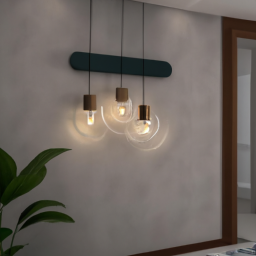
LED bulbs are a great choice for energy-efficient lighting. When it comes to LED vs CFL lighting, LED bulbs are the clear winner. Not only do they consume less energy, but they also last longer, saving you money in the long run. LED bulbs have a lifespan of up to 50,000 hours compared to CFL bulbs that typically last around 10,000 hours.
In addition to energy efficiency, natural light optimization is another important aspect to consider when choosing lighting options for your home. Maximizing natural light can help reduce your reliance on artificial lighting during the day. To achieve this, make sure your windows are clean and unobstructed by curtains or blinds during daylight hours.
To further enhance natural light in your home, consider using lighter colors on walls and furniture as they reflect more light. Mirrors strategically placed opposite windows can also help bounce and amplify natural light throughout the room.
Water Conservation Strategies
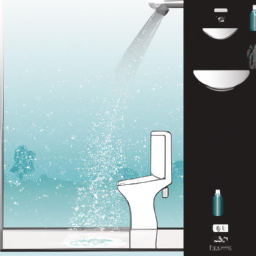
To conserve water, you can start by installing low-flow faucets and showerheads. These fixtures are designed to reduce water usage without compromising your experience. By simply swapping out your old fixtures with these efficient options, you can significantly decrease the amount of water wasted during everyday activities like washing dishes or taking a shower.
Another effective strategy for conserving water is rainwater harvesting. This involves collecting and storing rainwater for later use in gardens, toilets, or even laundry machines. It’s a simple and cost-effective way to make the most of nature’s gift while reducing your dependence on the municipal water supply.
Greywater recycling is another method that allows you to reuse household wastewater from sources like sinks, showers, and washing machines. With proper treatment systems, this recycled water can be used for irrigation or flushing toilets. It not only saves water but also reduces the strain on sewage systems and decreases overall demand for freshwater resources.
Sustainable Materials for Home Decor
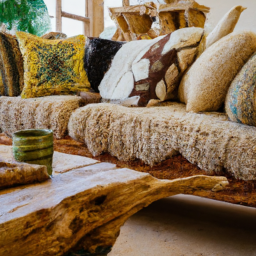
When choosing materials for your home decor, opt for sustainable options like bamboo or reclaimed wood furniture. Eco-friendly furniture not only adds a unique touch to your space but also helps reduce the negative impact on the environment. Bamboo is an excellent choice because it grows quickly and requires minimal resources to cultivate. It is a renewable resource that can be harvested without causing harm to the ecosystem. Reclaimed wood furniture, on the other hand, repurposes old wood from sources such as barns, warehouses, or even old furniture pieces. By using reclaimed wood, you are not only preventing trees from being cut down but also giving new life to materials that would otherwise go to waste.
In addition to eco-friendly materials, upcycling ideas can further enhance your sustainable home decor. Upcycling involves transforming discarded items into something new and useful. For example, you can turn old mason jars into stylish vases or use wine corks as drawer knobs. Not only does this reduce waste but also adds a personal touch to your decor.
Recycling and Waste Management Tips
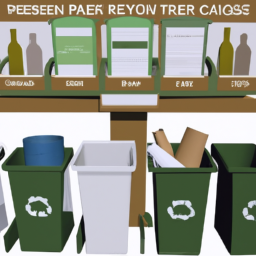
By properly sorting your recyclables and reducing waste, you can contribute to a healthier environment. Recycling and waste management play crucial roles in preserving our planet’s resources and reducing pollution. One effective way to minimize waste is by implementing composting techniques. Composting allows organic materials like food scraps, yard clippings, and paper to break down naturally, creating nutrient-rich soil for plants. You can start a compost pile in your backyard or use indoor compost bins if space is limited.
Another significant step towards a more eco-friendly lifestyle is reducing the use of single-use plastics. These items have become pervasive in our daily lives but pose a significant threat to the environment due to their non-biodegradable nature. Instead of relying on plastic water bottles, invest in reusable ones made from stainless steel or glass. Similarly, opt for cloth bags when shopping instead of accepting single-use plastic bags.
Remember that every small change makes a difference when it comes to waste management and recycling efforts. By incorporating these practices into your daily routine, you are actively contributing towards building a sustainable future for generations to come while protecting our precious environment.
Eco-Friendly Cleaning Products
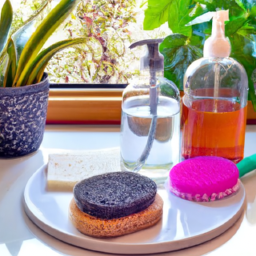
Using eco-friendly cleaning products is a simple way to reduce the environmental impact of your cleaning routine. When it comes to keeping your home clean and fresh, there are plenty of alternatives to traditional cleaning products that are both effective and environmentally friendly.
One area where you can make a positive change is in your laundry routine. Instead of using harsh chemical detergents, opt for green laundry products that are made from natural ingredients. These products not only clean your clothes effectively but also do not release harmful chemicals into the water supply when they are washed down the drain.
When it comes to disinfecting surfaces, many conventional disinfectants contain harsh chemicals that can be harmful to both people and the environment. Thankfully, there are natural disinfectants available that use ingredients like vinegar, hydrogen peroxide, or essential oils. These ingredients have antimicrobial properties and can effectively kill germs without leaving behind harmful residues.
Smart Home Technology for Energy Efficiency

Smart home technology can help reduce energy consumption and increase efficiency in your household. By incorporating smart home automation and energy monitoring systems, you can have greater control over your energy usage, leading to significant savings on your utility bills.
With smart home automation, you can easily manage and control various devices in your house. From thermostats that adjust the temperature based on occupancy patterns to lighting systems that turn off when no one is in the room, these automated features ensure that energy is only used when needed. Additionally, you can schedule appliances to run during off-peak hours when electricity rates are lower.
Energy monitoring systems play a crucial role in helping you understand how much energy each device consumes. These systems provide real-time data on your energy usage, allowing you to identify areas where improvements can be made. By recognizing which appliances or habits contribute the most to your energy consumption, you can make informed decisions about reducing waste.
Incorporating Renewable Energy Sources

Did you know that incorporating renewable energy sources into your household can significantly reduce your carbon footprint and contribute to a more sustainable future? By investing in solar panel installation and wind turbine integration, you can harness the power of the sun and wind to generate electricity for your home.
Solar panels are a popular choice for homeowners looking to incorporate renewable energy. These panels convert sunlight into usable electricity, which can be used to power appliances, lighting, and other electrical devices in your home. Installing solar panels on your roof allows you to take advantage of the abundant sunlight and turn it into clean, renewable energy.
Wind turbines are another option for generating renewable energy at home. These tall structures with spinning blades capture the kinetic energy from the wind and convert it into electricity. By integrating a wind turbine system on your property, you can tap into the power of the wind to supplement or even replace traditional grid electricity.
Both solar panel installation and wind turbine integration require careful planning and consideration. Factors such as location, available space, and local regulations should all be taken into account when deciding which option is best for your home. Additionally, it’s important to consult with professionals who specialize in renewable energy systems to ensure proper installation and maximize efficiency.
Incorporating renewable energy sources like solar panels and wind turbines not only reduces your reliance on fossil fuels but also helps combat climate change by reducing greenhouse gas emissions. By taking this step towards a more eco-friendly home, you are actively contributing to a greener future for yourself and generations to come.
Frequently Asked Questions
What Are Some Common Misconceptions About Energy-Efficient Lighting Options?
Common misconceptions about energy-efficient lighting options include the belief that they are too expensive, produce harsh lighting, and have limited design choices. However, these ideas are not entirely accurate. Energy-efficient lighting actually saves you money in the long run through reduced energy consumption. They also provide a warm and inviting glow while offering a wide range of styles and designs to suit your taste. So don’t let these misconceptions deter you from enjoying the benefits of eco-friendly lighting in your home.
What Are Some Creative Ways to Conserve Water in My Home?
To conserve water in your home, there are several creative ways you can try. Installing water-saving devices like low-flow showerheads and faucet aerators will reduce water usage without compromising functionality. Additionally, incorporating drought-resistant landscaping in your outdoor spaces can minimize the need for excess watering. These simple changes not only help you save on your monthly bills but also contribute to conserving our precious water resources.
Are There Any Sustainable Materials That Can Be Used for Home Decor That Are Also Affordable?
Looking for sustainable decor materials that won’t break the bank? There are plenty of affordable options out there! Bamboo is a versatile and eco-friendly choice for furniture and flooring. Cork can be used as an alternative to traditional wall coverings, providing insulation and soundproofing. Recycled glass tiles make beautiful backsplashes or countertops, while reclaimed wood adds character and warmth to any space. When it comes to making your home more eco-friendly, these sustainable decor materials are worth considering!
What Are Some Recycling and Waste Management Tips Specifically for Apartment Dwellers?
Recycling tips and waste management tips can be especially helpful for apartment dwellers. When it comes to recycling, make sure you separate your recyclables from your regular trash and utilize the designated recycling bins in your building or community. Reduce waste by choosing reusable products instead of single-use items, such as using cloth bags instead of plastic ones. Additionally, composting is a great way to minimize food waste and create nutrient-rich soil for plants.
Are There Any Eco-Friendly Cleaning Products That Are Safe to Use Around Pets and Children?
When it comes to eco-friendly cleaning products for pets and children, safety is a top priority. There are many options available that are both effective and safe. Look for products that are labeled as non-toxic, biodegradable, and made from sustainable ingredients. These products will not only keep your home clean but also protect the health of your loved ones. Additionally, consider incorporating sustainable home decor options to further enhance the eco-friendliness of your living space.
Conclusion
In conclusion, making your home more eco-friendly is not only beneficial for the environment but also for your wallet. By opting for energy-efficient lighting options and implementing water conservation strategies, you can reduce your carbon footprint while saving on utility bills. Choosing sustainable materials for home decor and practicing proper recycling and waste management also contribute to a greener lifestyle. Additionally, using eco-friendly cleaning products and incorporating smart home technology can further enhance energy efficiency. Lastly, consider incorporating renewable energy sources to power your home sustainably. With these practical steps, you can create an environmentally conscious living space that promotes a healthier planet for future generations.